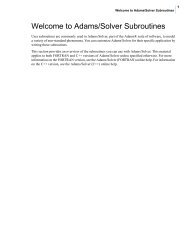Create successful ePaper yourself
Turn your PDF publications into a flip-book with our unique Google optimized e-Paper software.
The $FSEQ Function<br />
result=$FSEQ([a1[,a2[,…]])<br />
Returns: Sequence<br />
<strong>Virtual</strong> <strong>Machine</strong> Reference, Model Customization<br />
Simulation Macro Functions, Character and Sequence Functions<br />
This function provides an obsolete method of constructing a sequence. The $FSEQ function<br />
returns a sequence equivalent to all the arguments it is called with. The macro { } sequence<br />
operator should be used instead of $FSEQ. For example, specify {a1,a2} instead of<br />
$FSEQ(a1,a2).<br />
The $FSUBSQ Function<br />
result=$FSUBSQ(q,n1,n2)<br />
Returns: Sequence<br />
This function provides an obsolete method of returning zero or more elements of a sequence<br />
variable. This function returns the portion of the sequence q starting at element number n1 and<br />
ending at element number n2. Both n1 and n2 must be positive non-zero values. If n2 is less than<br />
n1, a sequence of length zero is returned. The macro : (colon) operator should be used instead of<br />
$FSUBSQ. For example, specify q(n1:n2) instead of $FSUBSQ(q,n1,n2).<br />
The $FSUBST Function<br />
result=$FSUBST(a1,a2,a3)<br />
Returns: String<br />
This function provides an obsolete method of returning a portion of a string variable. This<br />
function returns the portion of the string a1 starting at character position a2 and ending at<br />
character position a3. Both a2 and a3 must be positive non-zero values. If a3 is less than a2, a<br />
blank string is returned. The macro : operator should be used instead of $FSUBST. For example,<br />
specify a1(a2:a3) instead of $FSUBST(a1,a2,a3).<br />
The $FSWRIT Function<br />
result=$FSWRIT(s[,a1[,a2[,…]]])<br />
Returns: String<br />
This function returns the string s into which the subsequent arguments a1, a2, etc, have been<br />
formatted. It effectively does an internal write of the arguments into the format string and returns<br />
the result. The returned string is produced by inserting the arguments into the string s wherever<br />
special format characters are found. More information on these formatting characters can be<br />
found in “Output String Format Specifications” on page 139.<br />
<strong>ICAM</strong> Technologies Corporation – Proprietary 173















